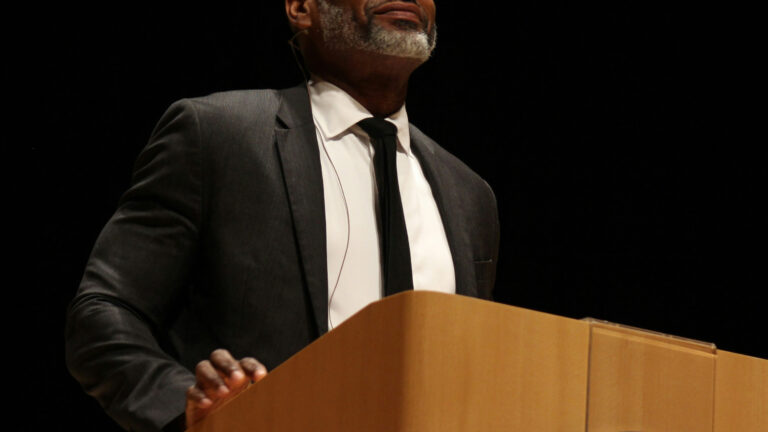Throughout this article, “worship” doesn’t refer to (a) glorifying God in all of life or (b) singing in church. Instead, in keeping with the Reformed tradition, by worship the author means our Sunday gatherings or church services.
When ships arrive at the Panama Canal, their helmsman steps away from the wheel, and an expert pilot takes control of the ship. It doesn’t matter if a ship has been through a thousand times: canals are challenging to navigate. They are much narrower than the open ocean, and it requires familiarity and expertise to pass through safely. Those expert pilots know their canal inside and out, and are therefore able to skilfully guide the ship through.
This series aims to prepare you for leading worship that glorifies God and serves your congregation.
Leading the service or worship in Sunday services is much the same. Whether it’s our first time attending or we’re deeply familiar, we need a skilled hand that can help us to navigate what’s happening. This is the role of the service leader. Whether you’ve never led a service or if you’re a regular, this series of articles aims to prepare you to do so in a way that glorifies God and serves your congregation.
Biblical Worship Is Well Structured
The first step to competently leading worship in a service is to know its structure. How can a ship’s pilot guide a ship if they don’t know the destination or if they’re unaware of the twists and turns of the canal? The aim of our worship is straightforward: it is to glorify our great God. As long as we faithfully gather around God’s word as believers, we gather to bring God glory through our praise and worship, and to be equipped to glorify him in our everyday lives. But the structure of our specific services will be different, and as a service leader, your first port of call is to learn the waters of your own canal.
The first step to competently leading worship in a service is to know its structure.
The foundation of any structure must be scripture. God’s word teaches us how to worship him, and so the scriptures must be considered as completely fundamental to the structure of our service (also called a liturgy); they’re the rules for piloting a ship, if you will.
All services should include four elements:
- Praise
- Confession of sins
- Word and sacrament
- Benediction or blessing
A brief word on each.
1. Praise
In Isaiah 6:1-8, the prophet witnesses a vision of God’s glory, where angels continually praise God. This is the foundation of our worship: praising our great God for his identity and his actions. Elements of the service that fit this aspect might be calls to worship, songs of praise, and prayers of adoration or thanksgiving.
2. Confession
When we see God’s glory, like Isaiah, we realise our own fallenness in comparison. We see how rich God’s grace is, and how desperately we need to receive it through his Son. This might look like a corporate prayer of confession or a private time of reflection and should be followed by words of gospel comfort: we have received God’s grace in Christ (Daniel 9:9-10; also 1 John 1:9-10).
3. Word and Sacraments
These words of comfort should lead us to remind ourselves of the gospel. In the Sunday service, we remind ourselves what God has done and worship him on that basis. As we do so, we declare what God has done and invite others to join our worship. This reminder should be chiefly through the preaching of God’s word and the celebration of the sacraments. Remember Paul, who longs to proclaim the gospel to Christians in Rome (Romans 1:15). However, this reminder of gospel grace might also include testimonies of faith or prayers of intercession.
4. Benediction or Blessing
God’s grace must transform us and renew us. We see God’s grace at work in Isaiah 6:8 when the prophet responds saying, “Here I am! Send me.” Likewise, believers are to go out from the service, reminded of and refreshed by God’s grace in Christ, into the world, eager to show Christ’s love through lives of service. This part of our worship is seen in intercessory prayer for the community around us, the collection of the offering to support ministry, testimonies of God at work in the world, our announcements, and of course the benediction at the end of the service. All these parts of the service connect our faith to our everyday worship.
The Place of Theological Tradition and Audience
The next influence on your service structure will be your church tradition. This might be historical. It might be denominational. As a service leader, you want to guide your congregation through the waters they’re familiar with. Be sensitive to these traditions while upholding scripture as your supreme authority. A good way to do this is to familiarise yourself with your denomination’s doctrinal statement, or the creeds and confessions your denomination holds to. You don’t need to bring these documents into every service. But a basic understanding of your theological heritage will help you to better suit your leading to your context.
Am I asking you to see the structure or create a structure? A bit of both.
The last influence on the structure of your service will be your congregation. I’d recommend taking very basic notes of the structure of services at your church, simply observing other leaders, or if your church has a livestream, following along and simply observing the structure. These notes will help you to see how you might want to structure the service when you lead, in a way that is most helpful in your context.
Am I asking you to see the structure or create a structure? A bit of both. As you look at the scriptures, your church tradition, and your congregation, your service structure will become more and more clear. This will help you to move to the next step, filling the gaps.
Leading Worship Well Means Filling the Gaps
You’ve seen the structure, now you need to help the congregation navigate through it. Your first step is to work out where you need to speak. As the service leader, your main role is to handle the transitions of the service, so that all can flow smoothly.
As the service begins, you handle the transition from everyday worship to the time set aside to worship God during a Sunday service. At its close, you’ll help the congregation make the transition back into everyday Christian living. Within the service, you’ll manage transitions between songs, readings, prayers, the preaching of the word, and the administration of the sacraments.
Understanding the structure of our worship services is critical to leading well.
Perhaps your church has a standard liturgy, and these transitions are always in the same locations. Perhaps you’ve got a much more flexible liturgy, and these points move around. Regardless, you need to work out where they will be, and then prepare for them.
It’s also worth noting that sometimes you are often responsible for parts of the service that aren’t transitions. These might include a prayer of adoration, praising God, intercession, praying for the needs of others, a prayer of illumination before the reading, and a prayer at the end of the service to tie it all together. Work out what you’re responsible for and search for a few examples of what they might look like.
When I first lead a service in a new church, I bring a full outline of the service, so that everything I will say has been written down. This certainly isn’t a requirement but helps me to be sensitive to a new context and to stay focused as I lead. This is the first part of your preparation: filling the gaps in the structure and making it whole.
Structure that Glorifies and Serves
Why begin a discussion of service leading speaking about structure? Simple. Just as a ship’s pilot must intimately know the canal they navigate through, service leading must understand the shape of the worship service. Understanding the structure of our worship services is critical to leading well. So we must grasp both the practical aspects of our services as well as the theology behind them.
Thoughtful theological consideration equips us to smoothly lead the congregation through the service.
By first understanding how scripture shapes the structure of our worship and then considering our church tradition and our context, we are enabled to worship the unchanging God according to his unchanging word in ever-changing cultural settings. This thoughtful theological consideration equips us to smoothly lead the congregation through the service as we worship God together, as service leaders who glorify God and serve the congregation.














